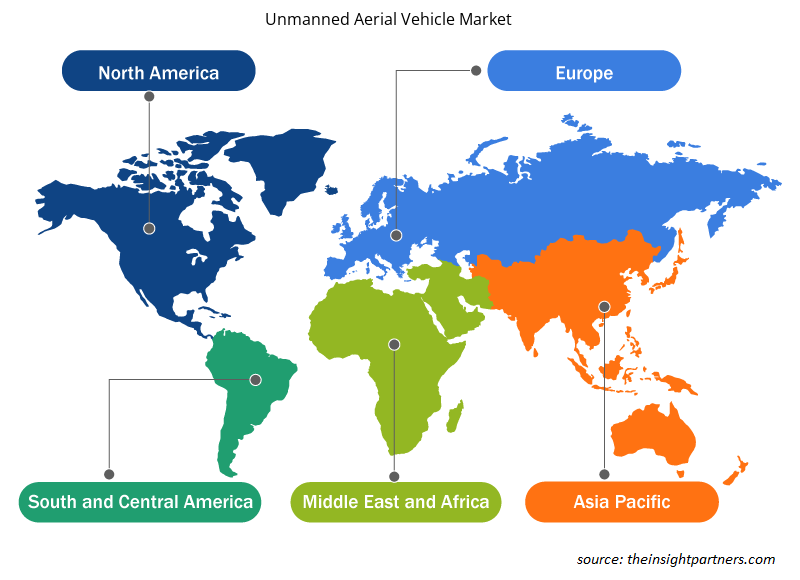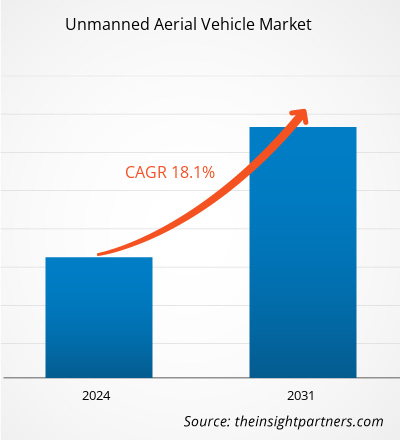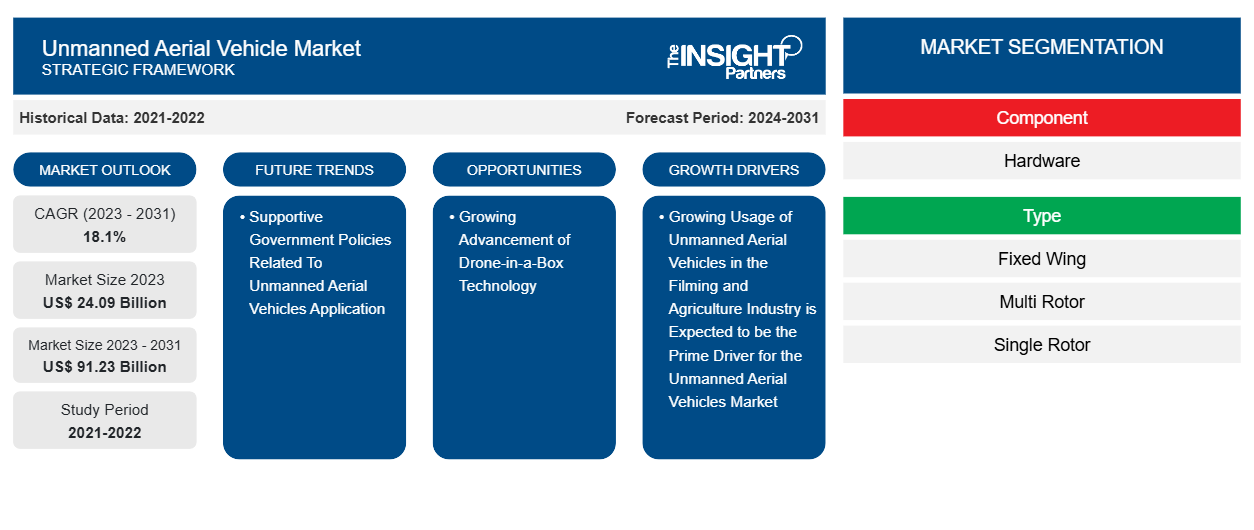Se proyecta que el tamaño del mercado de vehículos aéreos no tripulados alcance los 91,23 mil millones de dólares estadounidenses para 2031, frente a los 24,09 mil millones de dólares estadounidenses en 2023. Se espera que el mercado registre una CAGR del 18,1 % entre 2023 y 2031. La creciente proliferación de vehículos aéreos no tripulados para agricultura de precisión, fotografía y vigilancia está impulsando el crecimiento del mercado de vehículos aéreos no tripulados a nivel mundial.
Análisis del mercado de vehículos aéreos no tripulados
Se prevé que la creciente aplicación de vehículos aéreos no tripulados en diversas industrias de uso final, como la agricultura, el petróleo y el gas y la minería, impulse el crecimiento del mercado de vehículos aéreos no tripulados a nivel mundial. Se prevé que la creciente penetración de vehículos aéreos no tripulados en el sector de defensa y seguridad para capturar imágenes aéreas con el fin de mejorar las medidas para sistemas de defensa fuertes impulse el desarrollo del mercado de vehículos aéreos no tripulados en todo el mundo. Además, la creciente aplicación de vehículos aéreos no tripulados para cartografía y topografía, búsqueda de emergencia, respuesta, tareas de rescate, rescate marítimo y meteorología, entre otros, está impulsando el avance del mercado de vehículos aéreos no tripulados a nivel mundial. Los aspectos impulsados por IA, como el vuelo autónomo, el seguimiento de objetos y el procesamiento automatizado de imágenes, mejoraron las capacidades de los vehículos aéreos no tripulados y ayudaron a nuevas aplicaciones, lo que está teniendo un impacto positivo en el mercado de vehículos aéreos no tripulados.
Descripción general del mercado de vehículos aéreos no tripulados
La creciente proliferación de vehículos aéreos no tripulados para monitorear cualquier situación de siniestro, como inundaciones, terremotos o incendios, también está actuando como un importante impulsor del mercado. Los operadores de rescate aprovechan principalmente los drones para fines de vigilancia y monitoreo y para obtener una vista aérea de la situación general, lo que ayuda a tomar decisiones importantes con respecto a las formas de iniciar las operaciones de rescate. Además, la creciente aplicación de vehículos aéreos no tripulados en el sector de exploración de petróleo y gas y minería también está teniendo un impacto positivo en el mercado de vehículos aéreos no tripulados a nivel mundial. El mercado de vehículos aéreos no tripulados está segmentado por componente, tipo y aplicación. En términos de componente, el mercado de vehículos aéreos no tripulados se clasifica en hardware (cámara, sensores y otros) y software. Sobre la base del tipo, el mercado se clasifica en ala fija, multirrotor, rotor único e híbrido. Además, sobre la base de la aplicación, el mercado está segmentado en venta minorista, militar y defensa, medios y entretenimiento , personal, agricultura, industrial, aplicación de la ley y construcción.
Personalice este informe según sus necesidades
Obtendrá personalización en cualquier informe, sin cargo, incluidas partes de este informe o análisis a nivel de país, paquete de datos de Excel, así como también grandes ofertas y descuentos para empresas emergentes y universidades.
-
Obtenga las principales tendencias clave del mercado de este informe.Esta muestra GRATUITA incluirá análisis de datos, desde tendencias del mercado hasta estimaciones y pronósticos.
Factores impulsores y oportunidades del mercado de vehículos aéreos no tripulados
Uso creciente deSe espera que los vehículos aéreos no tripulados en la industria cinematográfica y agrícola sean el principal impulsor del mercado de vehículos aéreos no tripulados
La creciente demanda deLos vehículos aéreos no tripulados para filmar tomas aéreas y videografía en la industria de los medios y el entretenimiento son uno de los principales impulsores del mercado de vehículos aéreos no tripulados. La creciente aplicación de cámaras de drones de alta gama para capturar videos e imágenes aéreas de gran angular también está mejorando el crecimiento del mercado de vehículos aéreos no tripulados a nivel mundial. Se prevé que la creciente proliferación de la digitalización y la integración de aplicaciones de software para monitorear la eficiencia operativa general de las tierras agrícolas impulse el crecimiento del mercado de vehículos aéreos no tripulados a nivel mundial. Los datos en tiempo real y las imágenes aéreas de la granja completa ayudan a los agricultores a identificar los problemas relacionados con el bienestar de la tierra, que podrían afectar negativamente la tasa de producción de cultivos. Además, la gestión de tierras agrícolas de tamaño mediano a grande en ubicaciones remotas es inmanejable si no se utilizan cámaras UAV, ya que ayudan a capturar imágenes aéreas de la tierra para una mejor gestión operativa. Por lo tanto, la utilización de tecnologías avanzadas aparece como un factor impulsor importante para el mercado.
Políticas gubernamentales de apoyo relacionadas con la aplicación de vehículos aéreos no tripulados
Las políticas gubernamentales de apoyo a los drones ayudan en la gestión de tierras agrícolas, la entrega de paquetes en el mismo día, la filmación y la fotografía , y el monitoreo y captura de imágenes de sitios de petróleo y gas y minería. Por lo tanto, se anticipa que el creciente apoyo y asistencia gubernamentales para el uso de vehículos aéreos no tripulados avanzados para vigilancia, monitoreo y seguridad aumentará el desarrollo del mercado de vehículos aéreos no tripulados en los próximos años. Los crecientes disturbios geopolíticos y las crecientes situaciones similares a guerras están impulsando la aplicación de cámaras de vehículos aéreos no tripulados para fines de vigilancia, lo que se anticipa que impulsará la evolución del mercado durante el período de pronóstico.
Informe de mercado de vehículos aéreos no tripulados Análisis de segmentación
Los segmentos clave que contribuyeron a la derivación del análisis del mercado de vehículos aéreos no tripulados son el componente, el tipo y la aplicación.
- Según los componentes, el mercado de vehículos aéreos no tripulados se ha dividido en hardware (cámara, sensores y otros) y software. El segmento de hardware tuvo una mayor participación de mercado en 2023.
- En términos de tipo, el mercado se ha segmentado en ala fija, multirrotor, rotor único e híbrido. Los segmentos híbridos dominaron el mercado en 2023.
- En términos de aplicación, el mercado se ha segmentado en militar y defensa, comercio minorista, medios y entretenimiento, personal, agricultura, industria, aplicación de la ley y construcción. Los segmentos militar y de defensa dominaron el mercado en 2023.
Análisis de la cuota de mercado de vehículos aéreos no tripulados por geografía
El alcance geográfico del informe del mercado de vehículos aéreos no tripulados se divide principalmente en cinco regiones: América del Norte, Europa, Asia Pacífico, Medio Oriente y África, y América del Sur.
En 2023, América del Norte lideró el mercado de vehículos aéreos no tripulados. La región de América del Norte incluye Estados Unidos, Canadá y México. Muchas empresas de la región se están centrando en invertir en vehículos aéreos no tripulados avanzados para satisfacer los requisitos modernos de filmación, fotografía, agricultura, construcción, defensa y seguridad. Por lo tanto, se estima que la creciente aplicación de vehículos aéreos no tripulados para aumentar la agricultura de precisión, junto con la creciente demanda de vehículos aéreos no tripulados de alta gama para películas y fotografías, impulsará el desarrollo del mercado durante el período de pronóstico en América del Norte. La topografía y captura de imágenes de alta gama y el monitoreo e identificación de desafíos de seguridad también son algunas de las principales áreas de aplicación de los vehículos aéreos no tripulados en la región de América del Norte, lo que ayuda en la seguridad de la defensa y la racionalización de procesos en los sectores de petróleo y gas y minería. Un número cada vez mayor de actividades de exploración y producción de minería y petróleo y gas están impulsando la demanda de vehículos aéreos no tripulados para detectar, monitorear y capturar imágenes aéreas de los sitios para aumentar la gestión de las operaciones, lo que también está teniendo una influencia positiva en el mercado de vehículos aéreos no tripulados en América del Norte.
Perspectivas regionales del mercado de vehículos aéreos no tripulados
Los analistas de Insight Partners explicaron en detalle las tendencias y los factores regionales que influyen en el mercado de vehículos aéreos no tripulados durante el período de pronóstico. Esta sección también analiza los segmentos y la geografía del mercado de vehículos aéreos no tripulados en América del Norte, Europa, Asia Pacífico, Oriente Medio y África, y América del Sur y Central.

- Obtenga datos regionales específicos para el mercado de vehículos aéreos no tripulados
Alcance del informe sobre el mercado de vehículos aéreos no tripulados
| Atributo del informe | Detalles |
|---|---|
| Tamaño del mercado en 2023 | US$ 24.09 mil millones |
| Tamaño del mercado en 2031 | US$ 91,23 mil millones |
| CAGR global (2023 - 2031) | 18,1% |
| Datos históricos | 2021-2022 |
| Período de pronóstico | 2024-2031 |
| Segmentos cubiertos |
Por componente
|
| Regiones y países cubiertos |
América del norte
|
| Líderes del mercado y perfiles de empresas clave |
|
Densidad de actores del mercado de vehículos aéreos no tripulados: comprensión de su impacto en la dinámica empresarial
El mercado de vehículos aéreos no tripulados está creciendo rápidamente, impulsado por la creciente demanda de los usuarios finales debido a factores como la evolución de las preferencias de los consumidores, los avances tecnológicos y una mayor conciencia de los beneficios del producto. A medida que aumenta la demanda, las empresas amplían sus ofertas, innovan para satisfacer las necesidades de los consumidores y aprovechan las tendencias emergentes, lo que impulsa aún más el crecimiento del mercado.
La densidad de actores del mercado se refiere a la distribución de las empresas o firmas que operan dentro de un mercado o industria en particular. Indica cuántos competidores (actores del mercado) están presentes en un espacio de mercado determinado en relación con su tamaño o valor total de mercado.
Las principales empresas que operan en el mercado de vehículos aéreos no tripulados son:
- DJI
- Loro SA
- Robótica 3D Inc.
- Yuneec International Co. Ltd.
- Artículos de aviación
- AeroVironment Inc
Descargo de responsabilidad : Las empresas enumeradas anteriormente no están clasificadas en ningún orden particular.

- Obtenga una descripción general de los principales actores clave del mercado de vehículos aéreos no tripulados
Noticias y desarrollos recientes del mercado de vehículos aéreos no tripulados
El mercado de vehículos aéreos no tripulados se evalúa mediante la recopilación de datos cualitativos y cuantitativos posteriores a la investigación primaria y secundaria, que incluye publicaciones corporativas importantes, datos de asociaciones y bases de datos. A continuación, se incluye una lista de los desarrollos en el mercado de vehículos aéreos no tripulados y las estrategias:
- En abril de 2024, DJI lanzó los drones Agras T50 y Agras T25. (Fuente: DJI, comunicado de prensa/sitio web de la empresa/boletín informativo)
- En abril de 2024, la Administración de Material de Defensa de Suecia adquirió el UAV 06 Skatan de Parrot SA para su unidad de reserva militar de la Guardia Nacional. (Fuente: Parrot SA, comunicado de prensa/sitio web de la empresa/boletín informativo)
Informe sobre el mercado de vehículos aéreos no tripulados: cobertura y resultados
El informe “Tamaño y pronóstico del mercado de vehículos aéreos no tripulados (2021-2031)” proporciona un análisis detallado del mercado que cubre las siguientes áreas:
- Tamaño del mercado y pronóstico a nivel global, regional y nacional para todos los segmentos clave del mercado cubiertos bajo el alcance
- Dinámica del mercado, como impulsores, restricciones y oportunidades clave
- Principales tendencias futuras
- Análisis PEST detallado
- Análisis del mercado global y regional que cubre las tendencias clave del mercado, los principales actores, las regulaciones y los desarrollos recientes del mercado.
- Análisis del panorama de la industria y de la competencia que abarca la concentración del mercado, el análisis de mapas de calor, los actores destacados y los desarrollos recientes
- Perfiles de empresas detallados con análisis FODA
- Análisis histórico (2 años), año base, pronóstico (7 años) con CAGR
- Análisis PEST y FODA
- Tamaño del mercado, valor/volumen: global, regional y nacional
- Industria y panorama competitivo
- Conjunto de datos de Excel
Informes recientes
Informes relacionados
Testimonios
Razón para comprar
- Toma de decisiones informada
- Comprensión de la dinámica del mercado
- Análisis competitivo
- Información sobre clientes
- Pronósticos del mercado
- Mitigación de riesgos
- Planificación estratégica
- Justificación de la inversión
- Identificación de mercados emergentes
- Mejora de las estrategias de marketing
- Impulso de la eficiencia operativa
- Alineación con las tendencias regulatorias























 Obtenga una muestra gratuita para - Mercado de vehículos aéreos no tripulados
Obtenga una muestra gratuita para - Mercado de vehículos aéreos no tripulados